Project Management Plan: Co-operative Group Self-Checkout Systems
VerifiedAdded on 2023/06/14
|26
|5955
|133
Project
AI Summary
This document presents a comprehensive business project focused on the implementation of self-checkout systems at The Co-operative Group, a leading international retail company. It outlines the key stages of the project life cycle, including initiation, planning, execution, and closing, emphasizing their importance to project success. The project management plan (PMP) covers essential elements such as project requirements, product requirements, deliverables, quality control, risk assessment, communication resources, and research methods. The document also includes a literature review addressing the impact of COVID-19 on the work environment within the Co-operative Group, examining changes in shop layout, staff morale, sales, and customer service. It further explores the research methodologies employed, including primary and secondary research, work breakdown structure, and Gantt charts, to draw meaningful conclusions and recommendations for the project's success. This project aims to enhance efficiency, reduce costs, and improve customer experience through the strategic implementation of self-checkout technology.
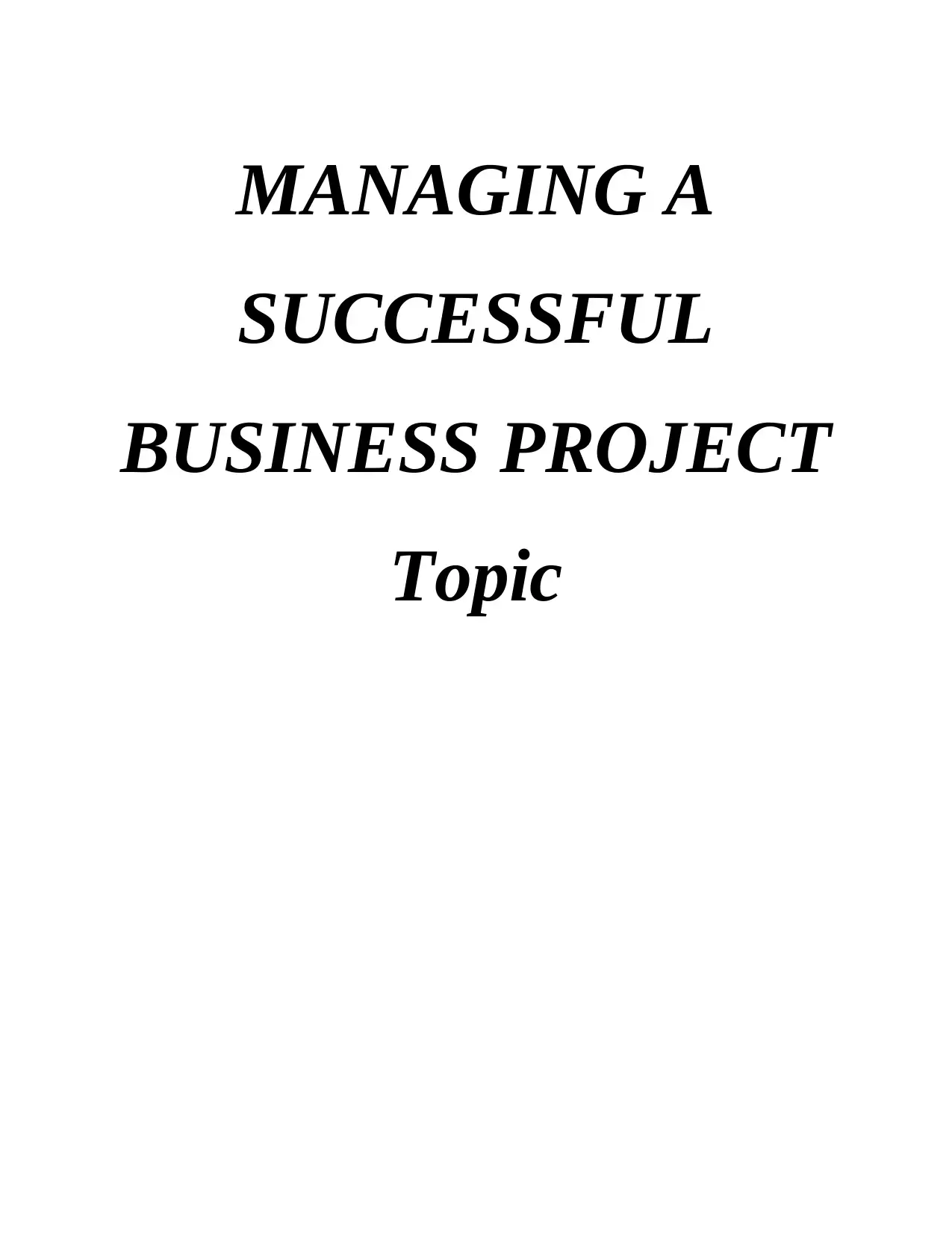
MANAGING A
SUCCESSFUL
BUSINESS PROJECT
Topic
SUCCESSFUL
BUSINESS PROJECT
Topic
Paraphrase This Document
Need a fresh take? Get an instant paraphrase of this document with our AI Paraphraser
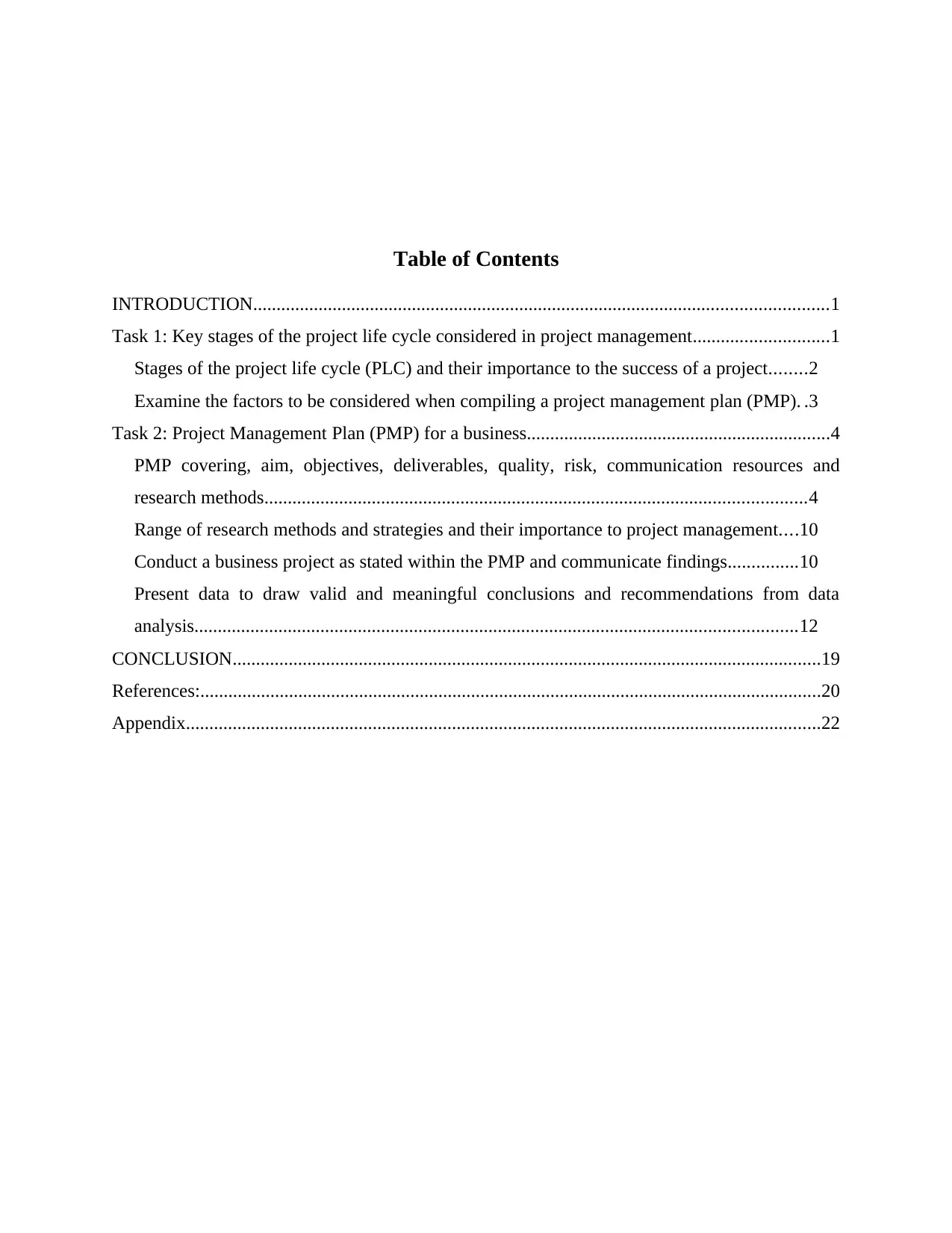
Table of Contents
INTRODUCTION...........................................................................................................................1
Task 1: Key stages of the project life cycle considered in project management.............................1
Stages of the project life cycle (PLC) and their importance to the success of a project........2
Examine the factors to be considered when compiling a project management plan (PMP). .3
Task 2: Project Management Plan (PMP) for a business.................................................................4
PMP covering, aim, objectives, deliverables, quality, risk, communication resources and
research methods....................................................................................................................4
Range of research methods and strategies and their importance to project management....10
Conduct a business project as stated within the PMP and communicate findings...............10
Present data to draw valid and meaningful conclusions and recommendations from data
analysis.................................................................................................................................12
CONCLUSION..............................................................................................................................19
References:.....................................................................................................................................20
Appendix........................................................................................................................................22
INTRODUCTION...........................................................................................................................1
Task 1: Key stages of the project life cycle considered in project management.............................1
Stages of the project life cycle (PLC) and their importance to the success of a project........2
Examine the factors to be considered when compiling a project management plan (PMP). .3
Task 2: Project Management Plan (PMP) for a business.................................................................4
PMP covering, aim, objectives, deliverables, quality, risk, communication resources and
research methods....................................................................................................................4
Range of research methods and strategies and their importance to project management....10
Conduct a business project as stated within the PMP and communicate findings...............10
Present data to draw valid and meaningful conclusions and recommendations from data
analysis.................................................................................................................................12
CONCLUSION..............................................................................................................................19
References:.....................................................................................................................................20
Appendix........................................................................................................................................22
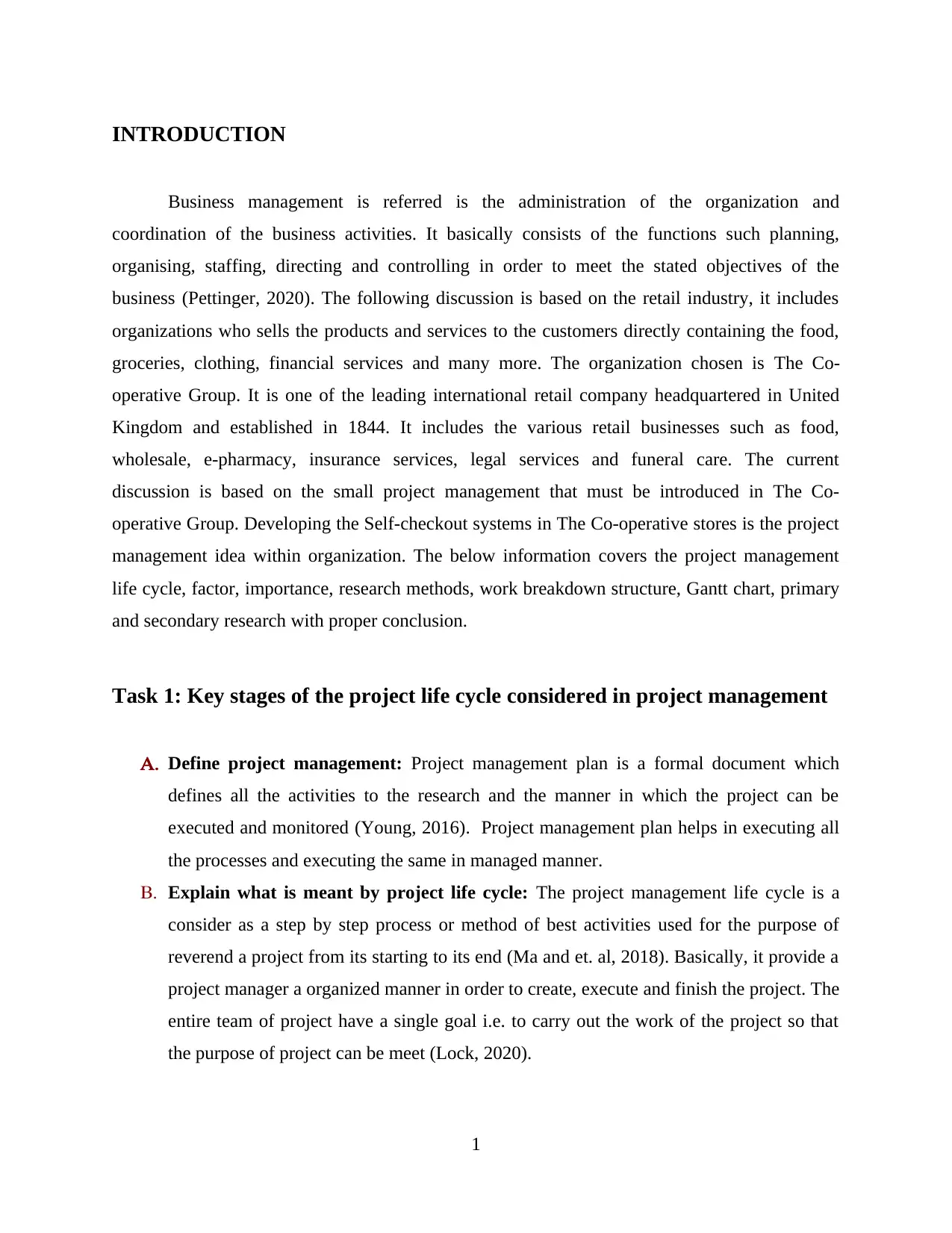
INTRODUCTION
Business management is referred is the administration of the organization and
coordination of the business activities. It basically consists of the functions such planning,
organising, staffing, directing and controlling in order to meet the stated objectives of the
business (Pettinger, 2020). The following discussion is based on the retail industry, it includes
organizations who sells the products and services to the customers directly containing the food,
groceries, clothing, financial services and many more. The organization chosen is The Co-
operative Group. It is one of the leading international retail company headquartered in United
Kingdom and established in 1844. It includes the various retail businesses such as food,
wholesale, e-pharmacy, insurance services, legal services and funeral care. The current
discussion is based on the small project management that must be introduced in The Co-
operative Group. Developing the Self-checkout systems in The Co-operative stores is the project
management idea within organization. The below information covers the project management
life cycle, factor, importance, research methods, work breakdown structure, Gantt chart, primary
and secondary research with proper conclusion.
Task 1: Key stages of the project life cycle considered in project management
A. Define project management: Project management plan is a formal document which
defines all the activities to the research and the manner in which the project can be
executed and monitored (Young, 2016). Project management plan helps in executing all
the processes and executing the same in managed manner.
B. Explain what is meant by project life cycle: The project management life cycle is a
consider as a step by step process or method of best activities used for the purpose of
reverend a project from its starting to its end (Ma and et. al, 2018). Basically, it provide a
project manager a organized manner in order to create, execute and finish the project. The
entire team of project have a single goal i.e. to carry out the work of the project so that
the purpose of project can be meet (Lock, 2020).
1
Business management is referred is the administration of the organization and
coordination of the business activities. It basically consists of the functions such planning,
organising, staffing, directing and controlling in order to meet the stated objectives of the
business (Pettinger, 2020). The following discussion is based on the retail industry, it includes
organizations who sells the products and services to the customers directly containing the food,
groceries, clothing, financial services and many more. The organization chosen is The Co-
operative Group. It is one of the leading international retail company headquartered in United
Kingdom and established in 1844. It includes the various retail businesses such as food,
wholesale, e-pharmacy, insurance services, legal services and funeral care. The current
discussion is based on the small project management that must be introduced in The Co-
operative Group. Developing the Self-checkout systems in The Co-operative stores is the project
management idea within organization. The below information covers the project management
life cycle, factor, importance, research methods, work breakdown structure, Gantt chart, primary
and secondary research with proper conclusion.
Task 1: Key stages of the project life cycle considered in project management
A. Define project management: Project management plan is a formal document which
defines all the activities to the research and the manner in which the project can be
executed and monitored (Young, 2016). Project management plan helps in executing all
the processes and executing the same in managed manner.
B. Explain what is meant by project life cycle: The project management life cycle is a
consider as a step by step process or method of best activities used for the purpose of
reverend a project from its starting to its end (Ma and et. al, 2018). Basically, it provide a
project manager a organized manner in order to create, execute and finish the project. The
entire team of project have a single goal i.e. to carry out the work of the project so that
the purpose of project can be meet (Lock, 2020).
1
⊘ This is a preview!⊘
Do you want full access?
Subscribe today to unlock all pages.

Trusted by 1+ million students worldwide
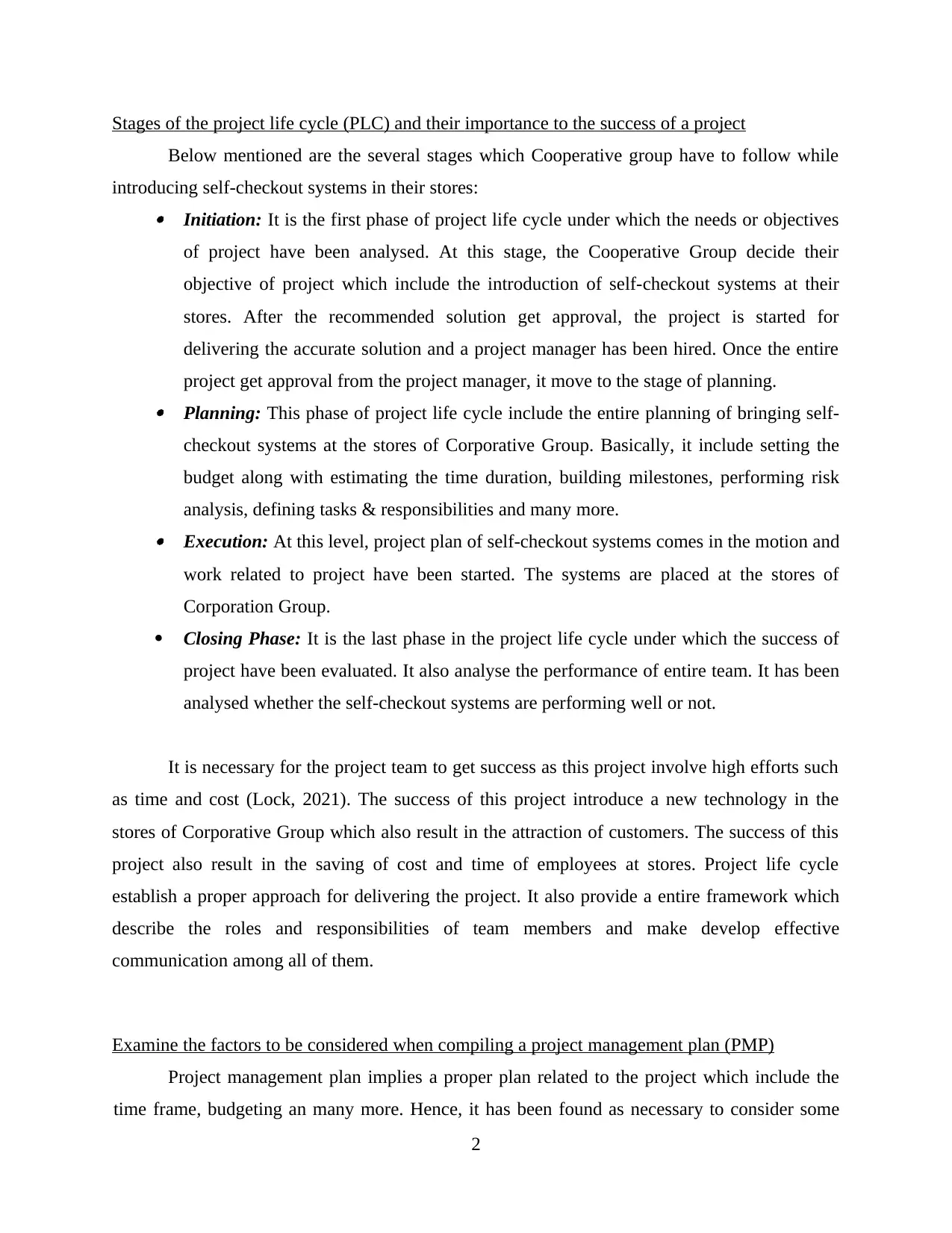
Stages of the project life cycle (PLC) and their importance to the success of a project
Below mentioned are the several stages which Cooperative group have to follow while
introducing self-checkout systems in their stores:
Initiation: It is the first phase of project life cycle under which the needs or objectives
of project have been analysed. At this stage, the Cooperative Group decide their
objective of project which include the introduction of self-checkout systems at their
stores. After the recommended solution get approval, the project is started for
delivering the accurate solution and a project manager has been hired. Once the entire
project get approval from the project manager, it move to the stage of planning.
Planning: This phase of project life cycle include the entire planning of bringing self-
checkout systems at the stores of Corporative Group. Basically, it include setting the
budget along with estimating the time duration, building milestones, performing risk
analysis, defining tasks & responsibilities and many more.
Execution: At this level, project plan of self-checkout systems comes in the motion and
work related to project have been started. The systems are placed at the stores of
Corporation Group.
Closing Phase: It is the last phase in the project life cycle under which the success of
project have been evaluated. It also analyse the performance of entire team. It has been
analysed whether the self-checkout systems are performing well or not.
It is necessary for the project team to get success as this project involve high efforts such
as time and cost (Lock, 2021). The success of this project introduce a new technology in the
stores of Corporative Group which also result in the attraction of customers. The success of this
project also result in the saving of cost and time of employees at stores. Project life cycle
establish a proper approach for delivering the project. It also provide a entire framework which
describe the roles and responsibilities of team members and make develop effective
communication among all of them.
Examine the factors to be considered when compiling a project management plan (PMP)
Project management plan implies a proper plan related to the project which include the
time frame, budgeting an many more. Hence, it has been found as necessary to consider some
2
Below mentioned are the several stages which Cooperative group have to follow while
introducing self-checkout systems in their stores:
Initiation: It is the first phase of project life cycle under which the needs or objectives
of project have been analysed. At this stage, the Cooperative Group decide their
objective of project which include the introduction of self-checkout systems at their
stores. After the recommended solution get approval, the project is started for
delivering the accurate solution and a project manager has been hired. Once the entire
project get approval from the project manager, it move to the stage of planning.
Planning: This phase of project life cycle include the entire planning of bringing self-
checkout systems at the stores of Corporative Group. Basically, it include setting the
budget along with estimating the time duration, building milestones, performing risk
analysis, defining tasks & responsibilities and many more.
Execution: At this level, project plan of self-checkout systems comes in the motion and
work related to project have been started. The systems are placed at the stores of
Corporation Group.
Closing Phase: It is the last phase in the project life cycle under which the success of
project have been evaluated. It also analyse the performance of entire team. It has been
analysed whether the self-checkout systems are performing well or not.
It is necessary for the project team to get success as this project involve high efforts such
as time and cost (Lock, 2021). The success of this project introduce a new technology in the
stores of Corporative Group which also result in the attraction of customers. The success of this
project also result in the saving of cost and time of employees at stores. Project life cycle
establish a proper approach for delivering the project. It also provide a entire framework which
describe the roles and responsibilities of team members and make develop effective
communication among all of them.
Examine the factors to be considered when compiling a project management plan (PMP)
Project management plan implies a proper plan related to the project which include the
time frame, budgeting an many more. Hence, it has been found as necessary to consider some
2
Paraphrase This Document
Need a fresh take? Get an instant paraphrase of this document with our AI Paraphraser
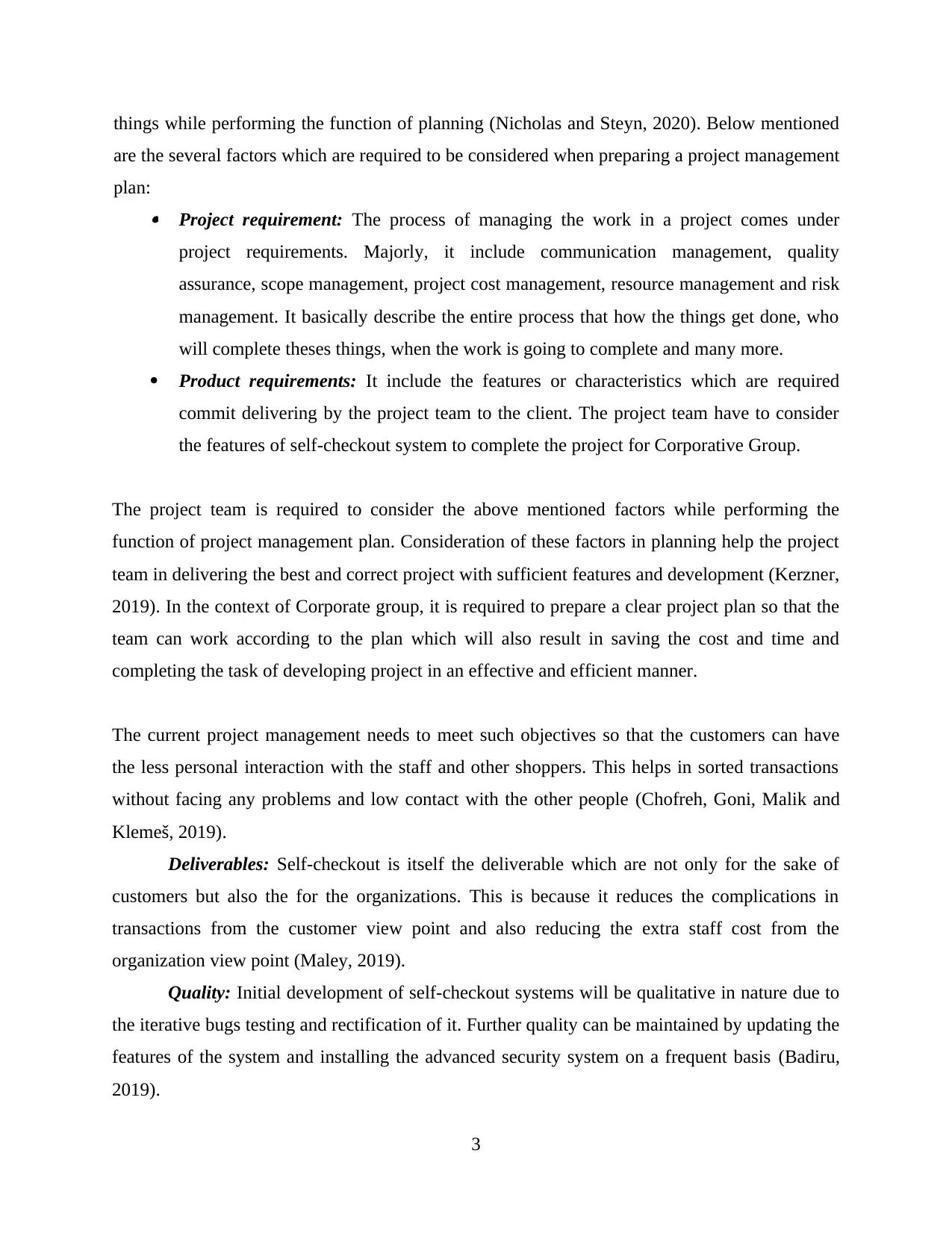
things while performing the function of planning (Nicholas and Steyn, 2020). Below mentioned
are the several factors which are required to be considered when preparing a project management
plan: Project requirement: The process of managing the work in a project comes under
project requirements. Majorly, it include communication management, quality
assurance, scope management, project cost management, resource management and risk
management. It basically describe the entire process that how the things get done, who
will complete theses things, when the work is going to complete and many more.
Product requirements: It include the features or characteristics which are required
commit delivering by the project team to the client. The project team have to consider
the features of self-checkout system to complete the project for Corporative Group.
The project team is required to consider the above mentioned factors while performing the
function of project management plan. Consideration of these factors in planning help the project
team in delivering the best and correct project with sufficient features and development (Kerzner,
2019). In the context of Corporate group, it is required to prepare a clear project plan so that the
team can work according to the plan which will also result in saving the cost and time and
completing the task of developing project in an effective and efficient manner.
The current project management needs to meet such objectives so that the customers can have
the less personal interaction with the staff and other shoppers. This helps in sorted transactions
without facing any problems and low contact with the other people (Chofreh, Goni, Malik and
Klemeš, 2019).
Deliverables: Self-checkout is itself the deliverable which are not only for the sake of
customers but also the for the organizations. This is because it reduces the complications in
transactions from the customer view point and also reducing the extra staff cost from the
organization view point (Maley, 2019).
Quality: Initial development of self-checkout systems will be qualitative in nature due to
the iterative bugs testing and rectification of it. Further quality can be maintained by updating the
features of the system and installing the advanced security system on a frequent basis (Badiru,
2019).
3
are the several factors which are required to be considered when preparing a project management
plan: Project requirement: The process of managing the work in a project comes under
project requirements. Majorly, it include communication management, quality
assurance, scope management, project cost management, resource management and risk
management. It basically describe the entire process that how the things get done, who
will complete theses things, when the work is going to complete and many more.
Product requirements: It include the features or characteristics which are required
commit delivering by the project team to the client. The project team have to consider
the features of self-checkout system to complete the project for Corporative Group.
The project team is required to consider the above mentioned factors while performing the
function of project management plan. Consideration of these factors in planning help the project
team in delivering the best and correct project with sufficient features and development (Kerzner,
2019). In the context of Corporate group, it is required to prepare a clear project plan so that the
team can work according to the plan which will also result in saving the cost and time and
completing the task of developing project in an effective and efficient manner.
The current project management needs to meet such objectives so that the customers can have
the less personal interaction with the staff and other shoppers. This helps in sorted transactions
without facing any problems and low contact with the other people (Chofreh, Goni, Malik and
Klemeš, 2019).
Deliverables: Self-checkout is itself the deliverable which are not only for the sake of
customers but also the for the organizations. This is because it reduces the complications in
transactions from the customer view point and also reducing the extra staff cost from the
organization view point (Maley, 2019).
Quality: Initial development of self-checkout systems will be qualitative in nature due to
the iterative bugs testing and rectification of it. Further quality can be maintained by updating the
features of the system and installing the advanced security system on a frequent basis (Badiru,
2019).
3
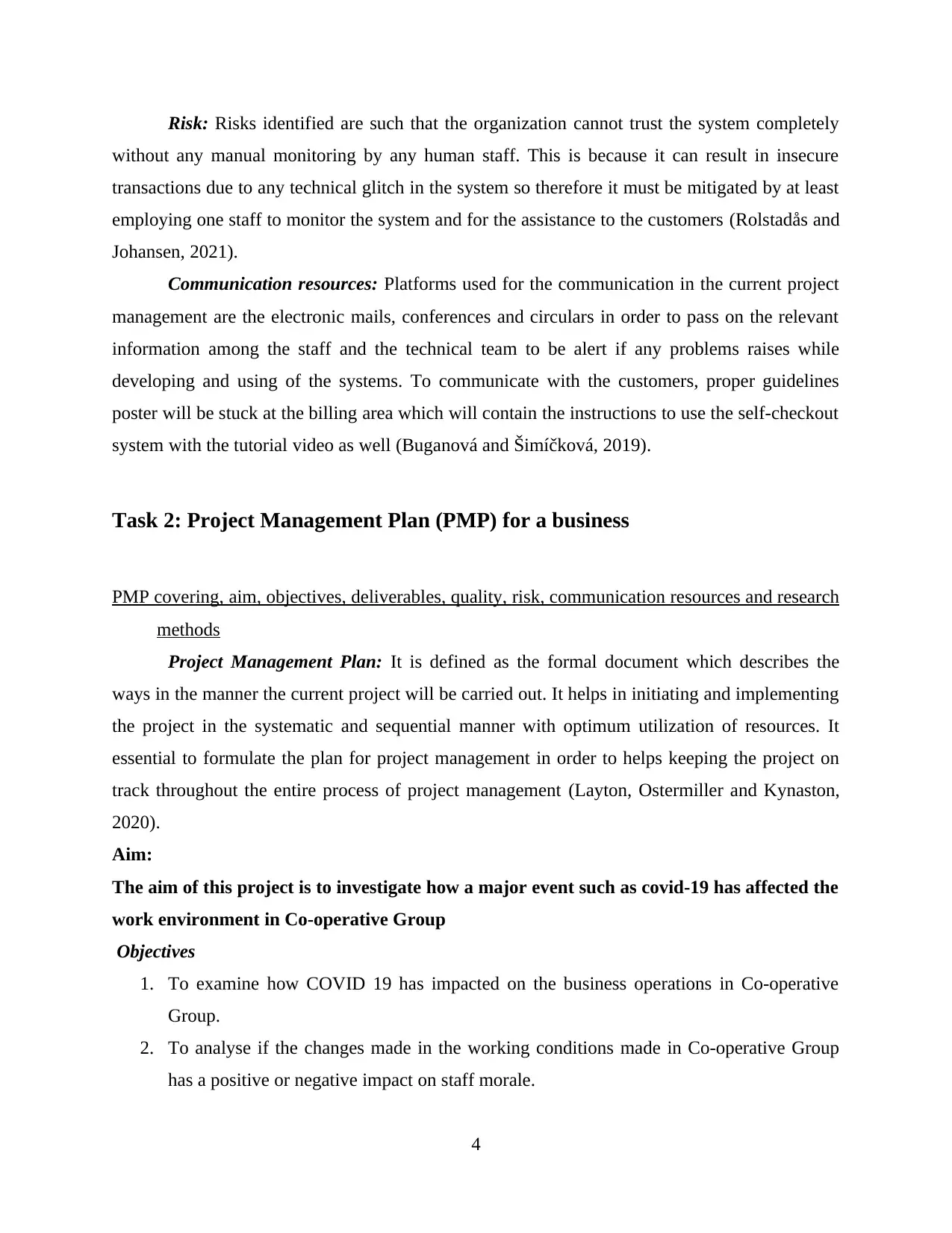
Risk: Risks identified are such that the organization cannot trust the system completely
without any manual monitoring by any human staff. This is because it can result in insecure
transactions due to any technical glitch in the system so therefore it must be mitigated by at least
employing one staff to monitor the system and for the assistance to the customers (Rolstadås and
Johansen, 2021).
Communication resources: Platforms used for the communication in the current project
management are the electronic mails, conferences and circulars in order to pass on the relevant
information among the staff and the technical team to be alert if any problems raises while
developing and using of the systems. To communicate with the customers, proper guidelines
poster will be stuck at the billing area which will contain the instructions to use the self-checkout
system with the tutorial video as well (Buganová and Šimíčková, 2019).
Task 2: Project Management Plan (PMP) for a business
PMP covering, aim, objectives, deliverables, quality, risk, communication resources and research
methods
Project Management Plan: It is defined as the formal document which describes the
ways in the manner the current project will be carried out. It helps in initiating and implementing
the project in the systematic and sequential manner with optimum utilization of resources. It
essential to formulate the plan for project management in order to helps keeping the project on
track throughout the entire process of project management (Layton, Ostermiller and Kynaston,
2020).
Aim:
The aim of this project is to investigate how a major event such as covid-19 has affected the
work environment in Co-operative Group
Objectives
1. To examine how COVID 19 has impacted on the business operations in Co-operative
Group.
2. To analyse if the changes made in the working conditions made in Co-operative Group
has a positive or negative impact on staff morale.
4
without any manual monitoring by any human staff. This is because it can result in insecure
transactions due to any technical glitch in the system so therefore it must be mitigated by at least
employing one staff to monitor the system and for the assistance to the customers (Rolstadås and
Johansen, 2021).
Communication resources: Platforms used for the communication in the current project
management are the electronic mails, conferences and circulars in order to pass on the relevant
information among the staff and the technical team to be alert if any problems raises while
developing and using of the systems. To communicate with the customers, proper guidelines
poster will be stuck at the billing area which will contain the instructions to use the self-checkout
system with the tutorial video as well (Buganová and Šimíčková, 2019).
Task 2: Project Management Plan (PMP) for a business
PMP covering, aim, objectives, deliverables, quality, risk, communication resources and research
methods
Project Management Plan: It is defined as the formal document which describes the
ways in the manner the current project will be carried out. It helps in initiating and implementing
the project in the systematic and sequential manner with optimum utilization of resources. It
essential to formulate the plan for project management in order to helps keeping the project on
track throughout the entire process of project management (Layton, Ostermiller and Kynaston,
2020).
Aim:
The aim of this project is to investigate how a major event such as covid-19 has affected the
work environment in Co-operative Group
Objectives
1. To examine how COVID 19 has impacted on the business operations in Co-operative
Group.
2. To analyse if the changes made in the working conditions made in Co-operative Group
has a positive or negative impact on staff morale.
4
⊘ This is a preview!⊘
Do you want full access?
Subscribe today to unlock all pages.

Trusted by 1+ million students worldwide
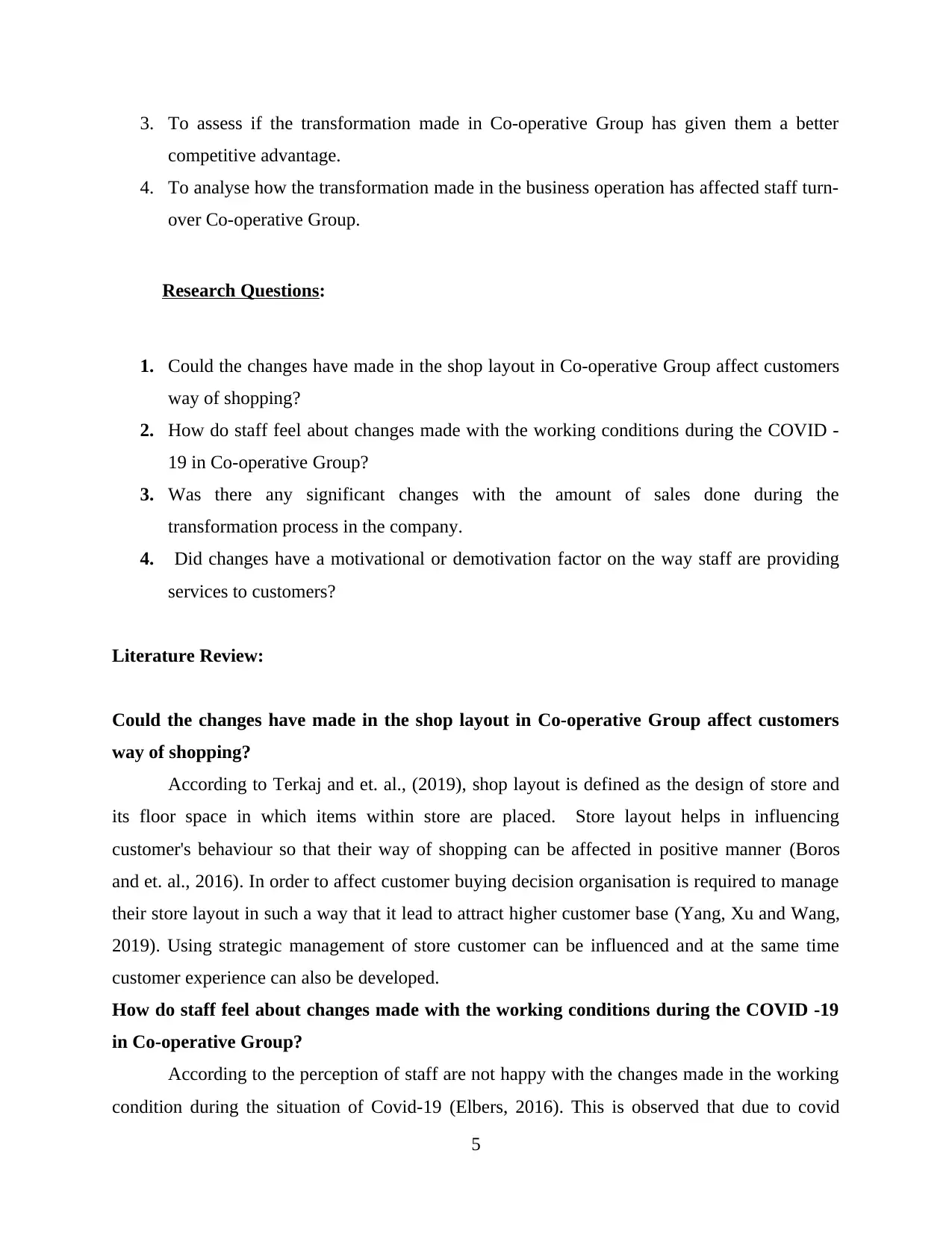
3. To assess if the transformation made in Co-operative Group has given them a better
competitive advantage.
4. To analyse how the transformation made in the business operation has affected staff turn-
over Co-operative Group.
Research Questions:
1. Could the changes have made in the shop layout in Co-operative Group affect customers
way of shopping?
2. How do staff feel about changes made with the working conditions during the COVID -
19 in Co-operative Group?
3. Was there any significant changes with the amount of sales done during the
transformation process in the company.
4. Did changes have a motivational or demotivation factor on the way staff are providing
services to customers?
Literature Review:
Could the changes have made in the shop layout in Co-operative Group affect customers
way of shopping?
According to Terkaj and et. al., (2019), shop layout is defined as the design of store and
its floor space in which items within store are placed. Store layout helps in influencing
customer's behaviour so that their way of shopping can be affected in positive manner (Boros
and et. al., 2016). In order to affect customer buying decision organisation is required to manage
their store layout in such a way that it lead to attract higher customer base (Yang, Xu and Wang,
2019). Using strategic management of store customer can be influenced and at the same time
customer experience can also be developed.
How do staff feel about changes made with the working conditions during the COVID -19
in Co-operative Group?
According to the perception of staff are not happy with the changes made in the working
condition during the situation of Covid-19 (Elbers, 2016). This is observed that due to covid
5
competitive advantage.
4. To analyse how the transformation made in the business operation has affected staff turn-
over Co-operative Group.
Research Questions:
1. Could the changes have made in the shop layout in Co-operative Group affect customers
way of shopping?
2. How do staff feel about changes made with the working conditions during the COVID -
19 in Co-operative Group?
3. Was there any significant changes with the amount of sales done during the
transformation process in the company.
4. Did changes have a motivational or demotivation factor on the way staff are providing
services to customers?
Literature Review:
Could the changes have made in the shop layout in Co-operative Group affect customers
way of shopping?
According to Terkaj and et. al., (2019), shop layout is defined as the design of store and
its floor space in which items within store are placed. Store layout helps in influencing
customer's behaviour so that their way of shopping can be affected in positive manner (Boros
and et. al., 2016). In order to affect customer buying decision organisation is required to manage
their store layout in such a way that it lead to attract higher customer base (Yang, Xu and Wang,
2019). Using strategic management of store customer can be influenced and at the same time
customer experience can also be developed.
How do staff feel about changes made with the working conditions during the COVID -19
in Co-operative Group?
According to the perception of staff are not happy with the changes made in the working
condition during the situation of Covid-19 (Elbers, 2016). This is observed that due to covid
5
Paraphrase This Document
Need a fresh take? Get an instant paraphrase of this document with our AI Paraphraser
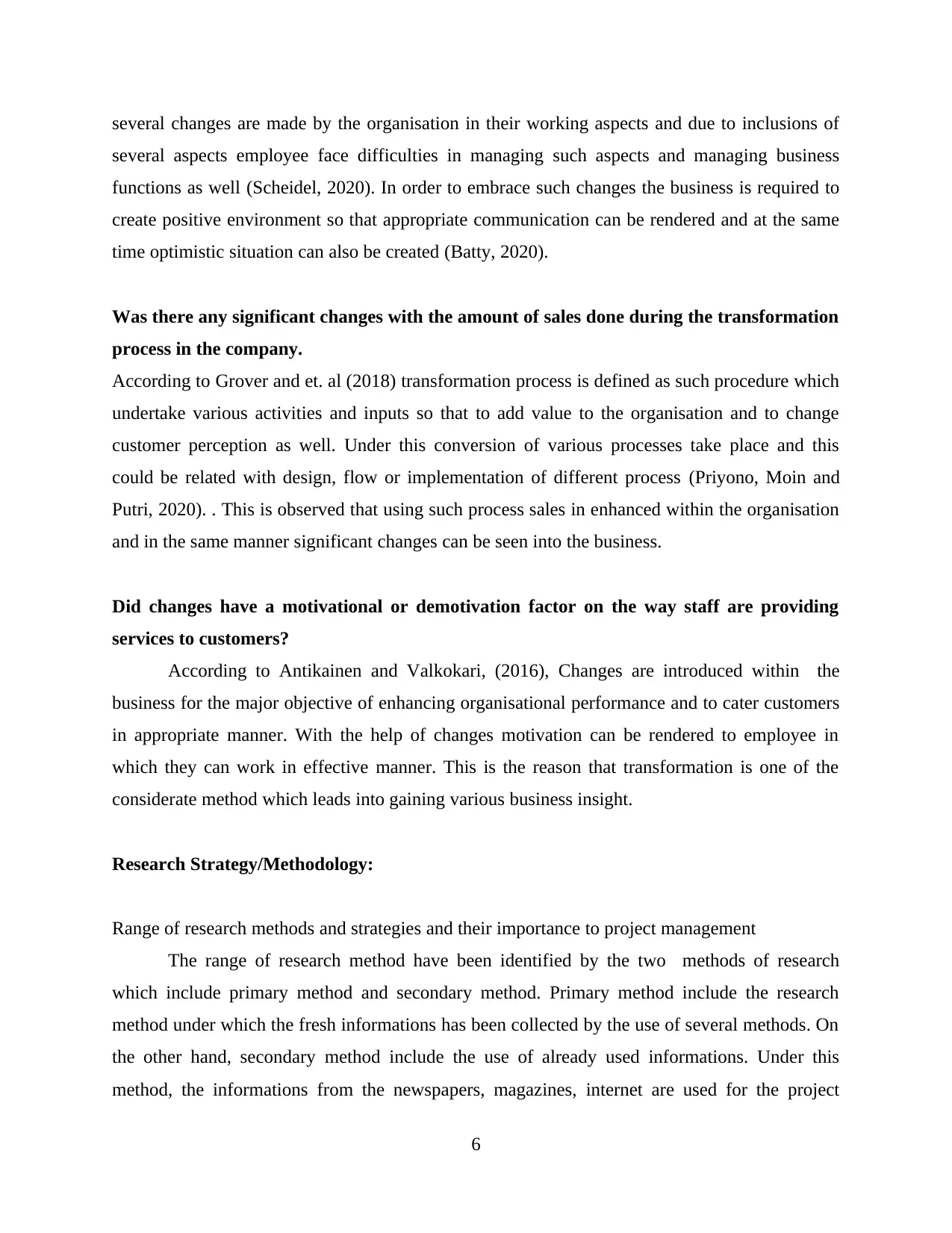
several changes are made by the organisation in their working aspects and due to inclusions of
several aspects employee face difficulties in managing such aspects and managing business
functions as well (Scheidel, 2020). In order to embrace such changes the business is required to
create positive environment so that appropriate communication can be rendered and at the same
time optimistic situation can also be created (Batty, 2020).
Was there any significant changes with the amount of sales done during the transformation
process in the company.
According to Grover and et. al (2018) transformation process is defined as such procedure which
undertake various activities and inputs so that to add value to the organisation and to change
customer perception as well. Under this conversion of various processes take place and this
could be related with design, flow or implementation of different process (Priyono, Moin and
Putri, 2020). . This is observed that using such process sales in enhanced within the organisation
and in the same manner significant changes can be seen into the business.
Did changes have a motivational or demotivation factor on the way staff are providing
services to customers?
According to Antikainen and Valkokari, (2016), Changes are introduced within the
business for the major objective of enhancing organisational performance and to cater customers
in appropriate manner. With the help of changes motivation can be rendered to employee in
which they can work in effective manner. This is the reason that transformation is one of the
considerate method which leads into gaining various business insight.
Research Strategy/Methodology:
Range of research methods and strategies and their importance to project management
The range of research method have been identified by the two methods of research
which include primary method and secondary method. Primary method include the research
method under which the fresh informations has been collected by the use of several methods. On
the other hand, secondary method include the use of already used informations. Under this
method, the informations from the newspapers, magazines, internet are used for the project
6
several aspects employee face difficulties in managing such aspects and managing business
functions as well (Scheidel, 2020). In order to embrace such changes the business is required to
create positive environment so that appropriate communication can be rendered and at the same
time optimistic situation can also be created (Batty, 2020).
Was there any significant changes with the amount of sales done during the transformation
process in the company.
According to Grover and et. al (2018) transformation process is defined as such procedure which
undertake various activities and inputs so that to add value to the organisation and to change
customer perception as well. Under this conversion of various processes take place and this
could be related with design, flow or implementation of different process (Priyono, Moin and
Putri, 2020). . This is observed that using such process sales in enhanced within the organisation
and in the same manner significant changes can be seen into the business.
Did changes have a motivational or demotivation factor on the way staff are providing
services to customers?
According to Antikainen and Valkokari, (2016), Changes are introduced within the
business for the major objective of enhancing organisational performance and to cater customers
in appropriate manner. With the help of changes motivation can be rendered to employee in
which they can work in effective manner. This is the reason that transformation is one of the
considerate method which leads into gaining various business insight.
Research Strategy/Methodology:
Range of research methods and strategies and their importance to project management
The range of research method have been identified by the two methods of research
which include primary method and secondary method. Primary method include the research
method under which the fresh informations has been collected by the use of several methods. On
the other hand, secondary method include the use of already used informations. Under this
method, the informations from the newspapers, magazines, internet are used for the project
6
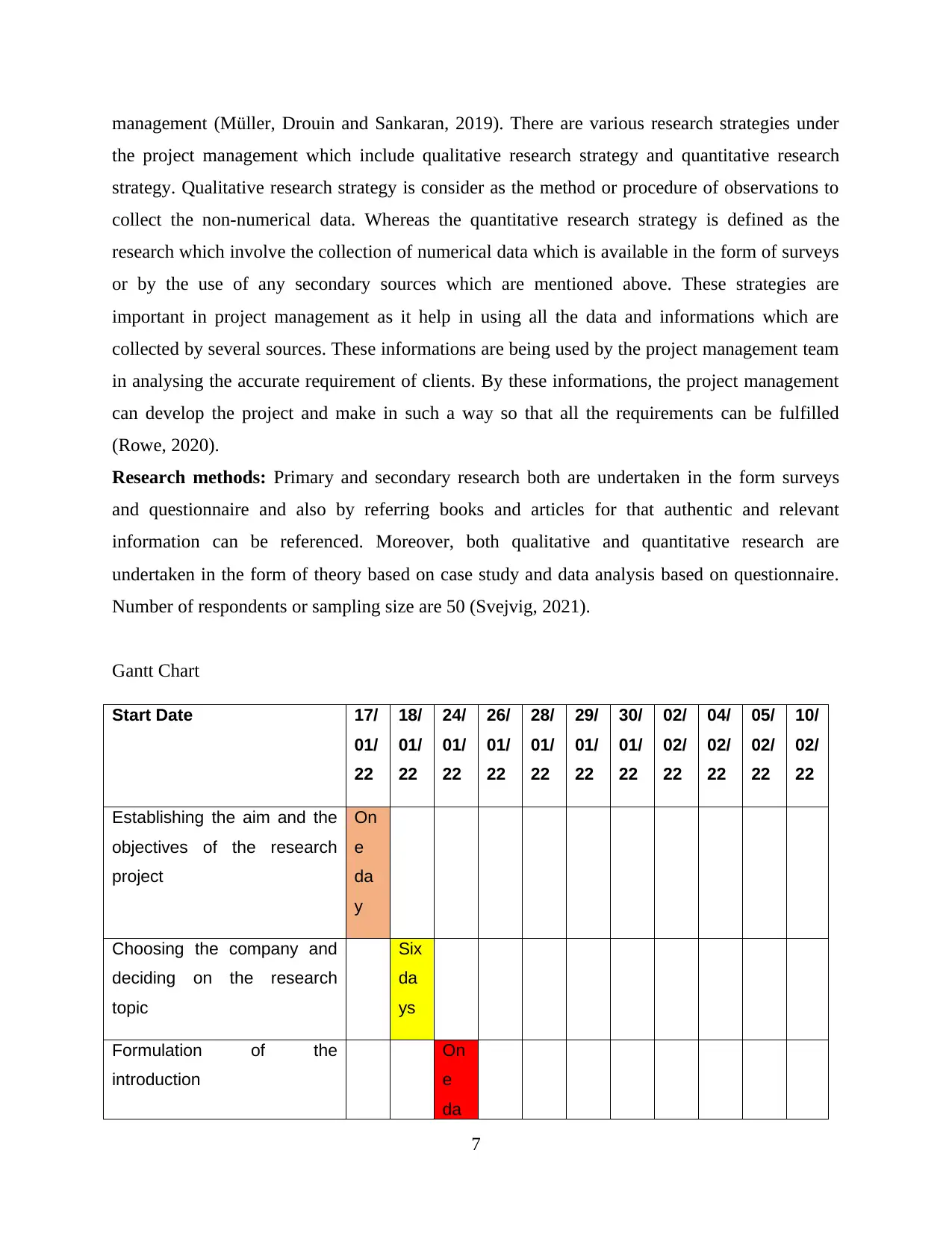
management (Müller, Drouin and Sankaran, 2019). There are various research strategies under
the project management which include qualitative research strategy and quantitative research
strategy. Qualitative research strategy is consider as the method or procedure of observations to
collect the non-numerical data. Whereas the quantitative research strategy is defined as the
research which involve the collection of numerical data which is available in the form of surveys
or by the use of any secondary sources which are mentioned above. These strategies are
important in project management as it help in using all the data and informations which are
collected by several sources. These informations are being used by the project management team
in analysing the accurate requirement of clients. By these informations, the project management
can develop the project and make in such a way so that all the requirements can be fulfilled
(Rowe, 2020).
Research methods: Primary and secondary research both are undertaken in the form surveys
and questionnaire and also by referring books and articles for that authentic and relevant
information can be referenced. Moreover, both qualitative and quantitative research are
undertaken in the form of theory based on case study and data analysis based on questionnaire.
Number of respondents or sampling size are 50 (Svejvig, 2021).
Gantt Chart
Start Date 17/
01/
22
18/
01/
22
24/
01/
22
26/
01/
22
28/
01/
22
29/
01/
22
30/
01/
22
02/
02/
22
04/
02/
22
05/
02/
22
10/
02/
22
Establishing the aim and the
objectives of the research
project
On
e
da
y
Choosing the company and
deciding on the research
topic
Six
da
ys
Formulation of the
introduction
On
e
da
7
the project management which include qualitative research strategy and quantitative research
strategy. Qualitative research strategy is consider as the method or procedure of observations to
collect the non-numerical data. Whereas the quantitative research strategy is defined as the
research which involve the collection of numerical data which is available in the form of surveys
or by the use of any secondary sources which are mentioned above. These strategies are
important in project management as it help in using all the data and informations which are
collected by several sources. These informations are being used by the project management team
in analysing the accurate requirement of clients. By these informations, the project management
can develop the project and make in such a way so that all the requirements can be fulfilled
(Rowe, 2020).
Research methods: Primary and secondary research both are undertaken in the form surveys
and questionnaire and also by referring books and articles for that authentic and relevant
information can be referenced. Moreover, both qualitative and quantitative research are
undertaken in the form of theory based on case study and data analysis based on questionnaire.
Number of respondents or sampling size are 50 (Svejvig, 2021).
Gantt Chart
Start Date 17/
01/
22
18/
01/
22
24/
01/
22
26/
01/
22
28/
01/
22
29/
01/
22
30/
01/
22
02/
02/
22
04/
02/
22
05/
02/
22
10/
02/
22
Establishing the aim and the
objectives of the research
project
On
e
da
y
Choosing the company and
deciding on the research
topic
Six
da
ys
Formulation of the
introduction
On
e
da
7
⊘ This is a preview!⊘
Do you want full access?
Subscribe today to unlock all pages.

Trusted by 1+ million students worldwide
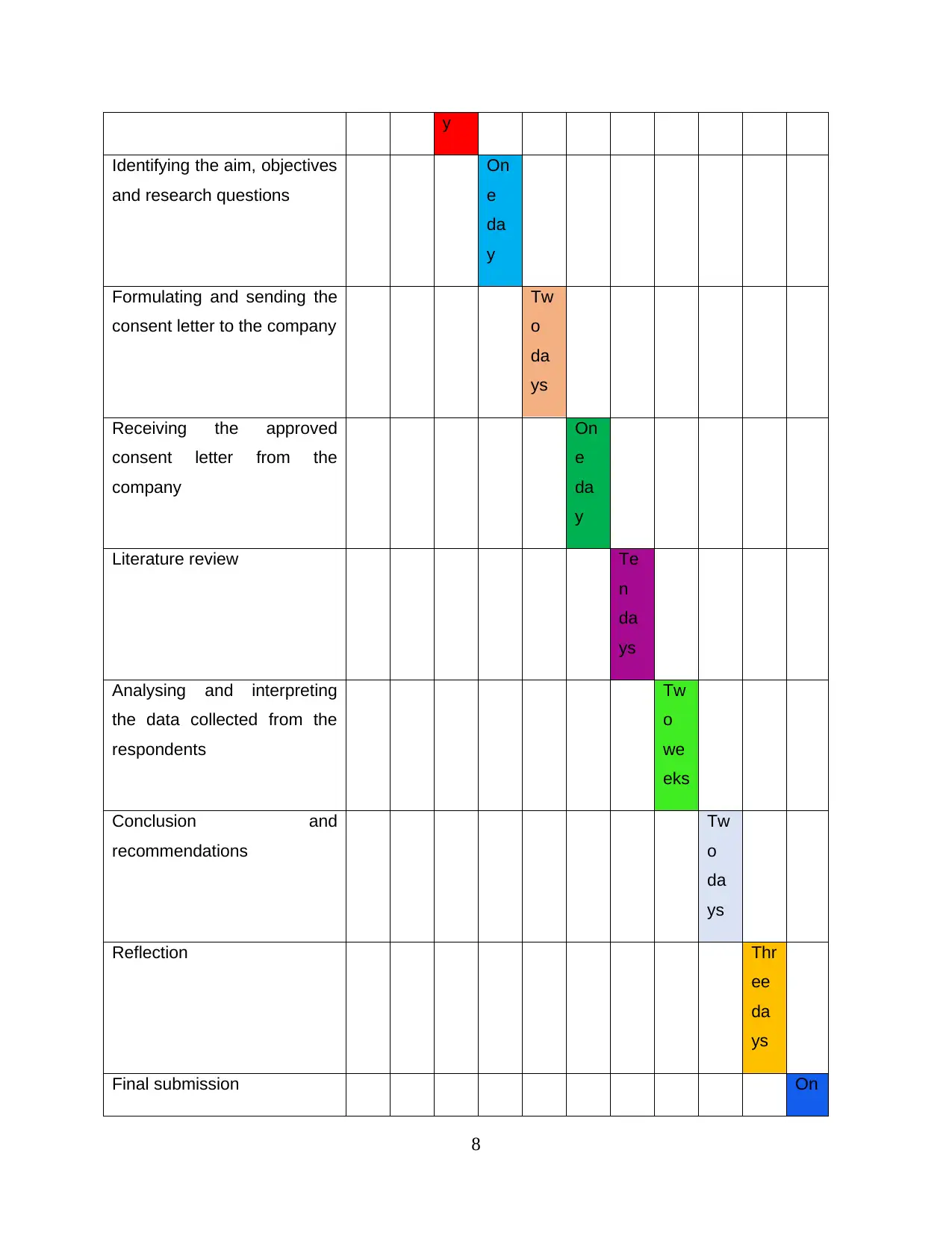
y
Identifying the aim, objectives
and research questions
On
e
da
y
Formulating and sending the
consent letter to the company
Tw
o
da
ys
Receiving the approved
consent letter from the
company
On
e
da
y
Literature review Te
n
da
ys
Analysing and interpreting
the data collected from the
respondents
Tw
o
we
eks
Conclusion and
recommendations
Tw
o
da
ys
Reflection Thr
ee
da
ys
Final submission On
8
Identifying the aim, objectives
and research questions
On
e
da
y
Formulating and sending the
consent letter to the company
Tw
o
da
ys
Receiving the approved
consent letter from the
company
On
e
da
y
Literature review Te
n
da
ys
Analysing and interpreting
the data collected from the
respondents
Tw
o
we
eks
Conclusion and
recommendations
Tw
o
da
ys
Reflection Thr
ee
da
ys
Final submission On
8
Paraphrase This Document
Need a fresh take? Get an instant paraphrase of this document with our AI Paraphraser
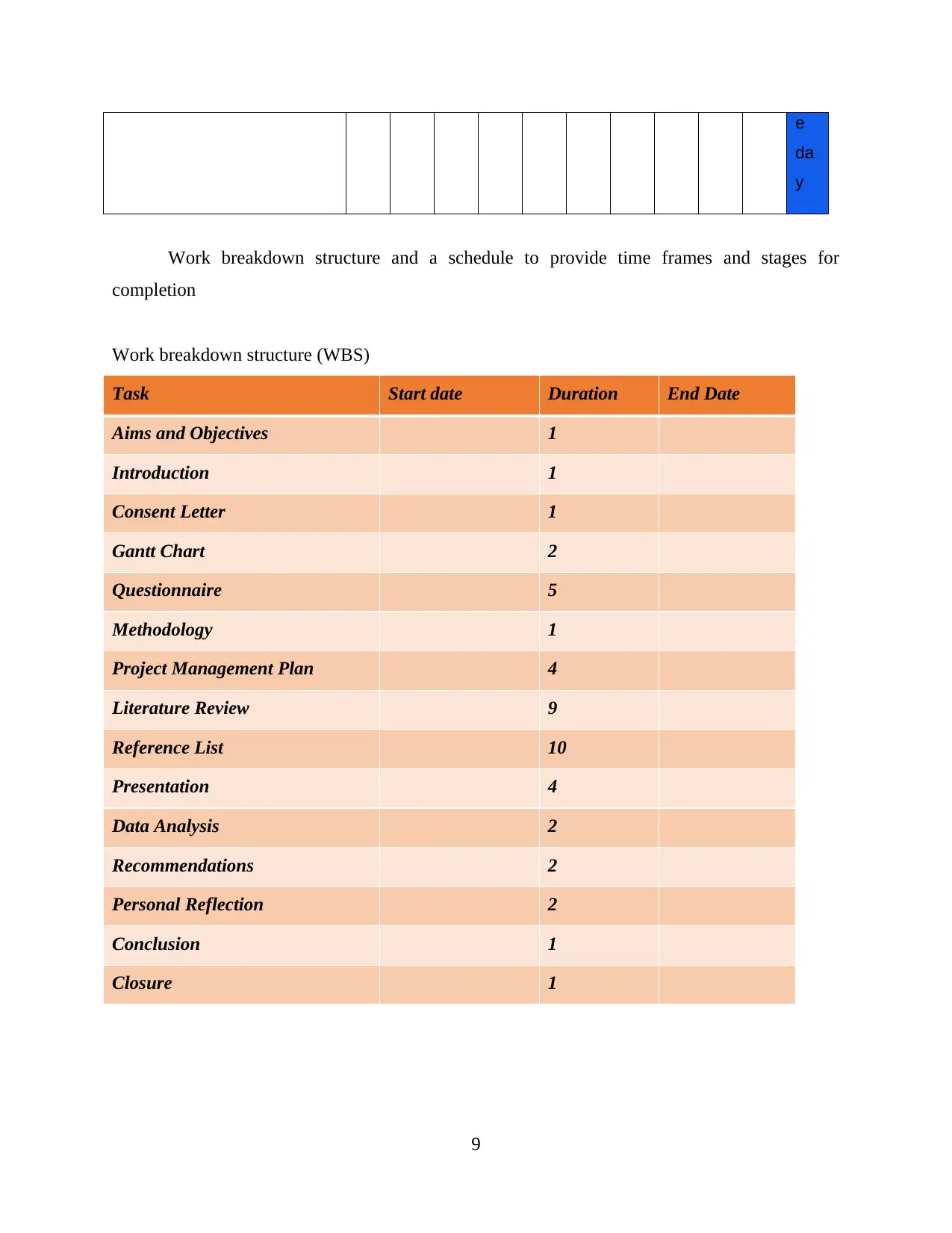
e
da
y
Work breakdown structure and a schedule to provide time frames and stages for
completion
Work breakdown structure (WBS)
Task Start date Duration End Date
Aims and Objectives 1
Introduction 1
Consent Letter 1
Gantt Chart 2
Questionnaire 5
Methodology 1
Project Management Plan 4
Literature Review 9
Reference List 10
Presentation 4
Data Analysis 2
Recommendations 2
Personal Reflection 2
Conclusion 1
Closure 1
9
da
y
Work breakdown structure and a schedule to provide time frames and stages for
completion
Work breakdown structure (WBS)
Task Start date Duration End Date
Aims and Objectives 1
Introduction 1
Consent Letter 1
Gantt Chart 2
Questionnaire 5
Methodology 1
Project Management Plan 4
Literature Review 9
Reference List 10
Presentation 4
Data Analysis 2
Recommendations 2
Personal Reflection 2
Conclusion 1
Closure 1
9
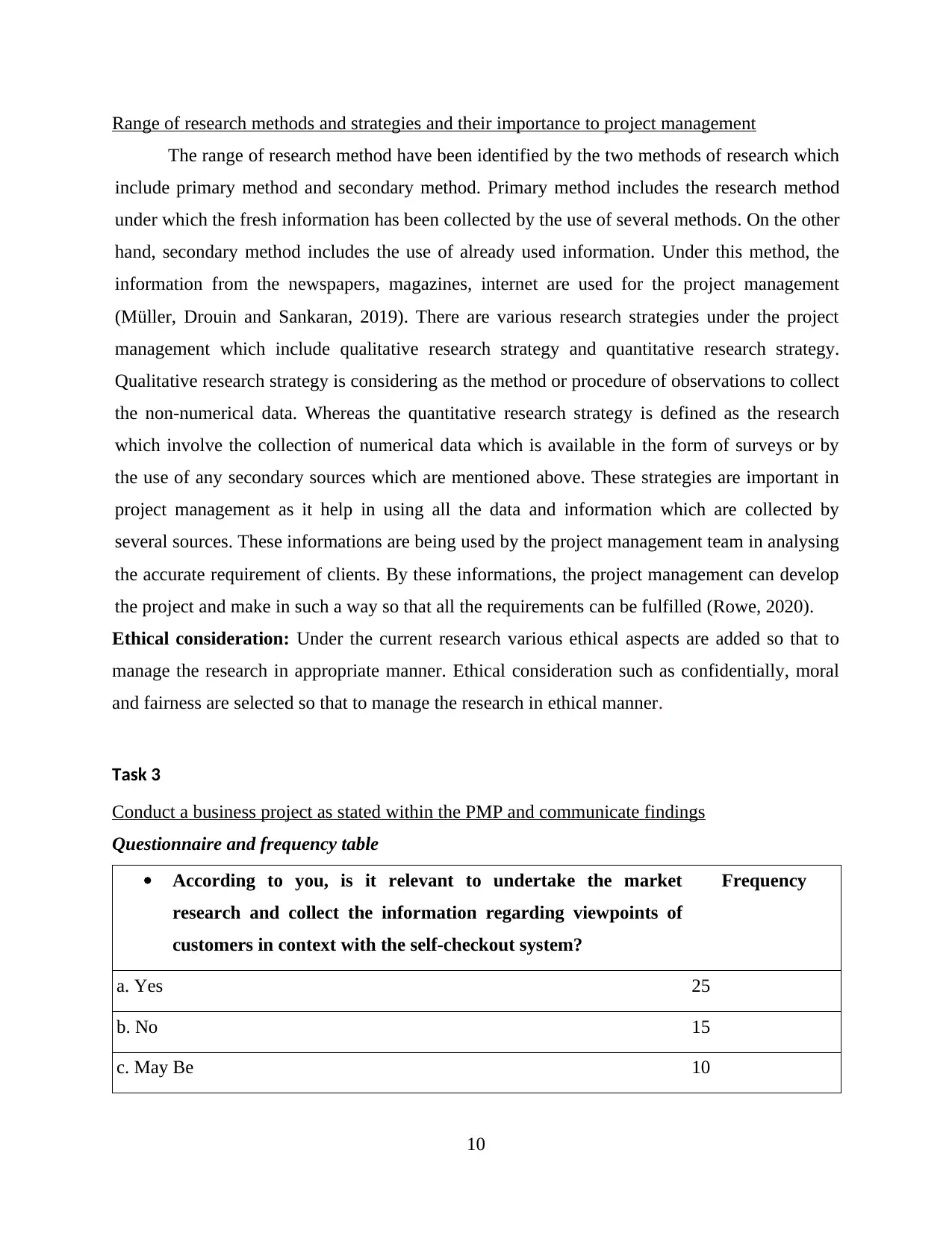
Range of research methods and strategies and their importance to project management
The range of research method have been identified by the two methods of research which
include primary method and secondary method. Primary method includes the research method
under which the fresh information has been collected by the use of several methods. On the other
hand, secondary method includes the use of already used information. Under this method, the
information from the newspapers, magazines, internet are used for the project management
(Müller, Drouin and Sankaran, 2019). There are various research strategies under the project
management which include qualitative research strategy and quantitative research strategy.
Qualitative research strategy is considering as the method or procedure of observations to collect
the non-numerical data. Whereas the quantitative research strategy is defined as the research
which involve the collection of numerical data which is available in the form of surveys or by
the use of any secondary sources which are mentioned above. These strategies are important in
project management as it help in using all the data and information which are collected by
several sources. These informations are being used by the project management team in analysing
the accurate requirement of clients. By these informations, the project management can develop
the project and make in such a way so that all the requirements can be fulfilled (Rowe, 2020).
Ethical consideration: Under the current research various ethical aspects are added so that to
manage the research in appropriate manner. Ethical consideration such as confidentially, moral
and fairness are selected so that to manage the research in ethical manner.
Task 3
Conduct a business project as stated within the PMP and communicate findings
Questionnaire and frequency table
According to you, is it relevant to undertake the market
research and collect the information regarding viewpoints of
customers in context with the self-checkout system?
Frequency
a. Yes 25
b. No 15
c. May Be 10
10
The range of research method have been identified by the two methods of research which
include primary method and secondary method. Primary method includes the research method
under which the fresh information has been collected by the use of several methods. On the other
hand, secondary method includes the use of already used information. Under this method, the
information from the newspapers, magazines, internet are used for the project management
(Müller, Drouin and Sankaran, 2019). There are various research strategies under the project
management which include qualitative research strategy and quantitative research strategy.
Qualitative research strategy is considering as the method or procedure of observations to collect
the non-numerical data. Whereas the quantitative research strategy is defined as the research
which involve the collection of numerical data which is available in the form of surveys or by
the use of any secondary sources which are mentioned above. These strategies are important in
project management as it help in using all the data and information which are collected by
several sources. These informations are being used by the project management team in analysing
the accurate requirement of clients. By these informations, the project management can develop
the project and make in such a way so that all the requirements can be fulfilled (Rowe, 2020).
Ethical consideration: Under the current research various ethical aspects are added so that to
manage the research in appropriate manner. Ethical consideration such as confidentially, moral
and fairness are selected so that to manage the research in ethical manner.
Task 3
Conduct a business project as stated within the PMP and communicate findings
Questionnaire and frequency table
According to you, is it relevant to undertake the market
research and collect the information regarding viewpoints of
customers in context with the self-checkout system?
Frequency
a. Yes 25
b. No 15
c. May Be 10
10
⊘ This is a preview!⊘
Do you want full access?
Subscribe today to unlock all pages.

Trusted by 1+ million students worldwide
1 out of 26
Related Documents
Your All-in-One AI-Powered Toolkit for Academic Success.
+13062052269
info@desklib.com
Available 24*7 on WhatsApp / Email
![[object Object]](/_next/static/media/star-bottom.7253800d.svg)
Unlock your academic potential
Copyright © 2020–2025 A2Z Services. All Rights Reserved. Developed and managed by ZUCOL.



